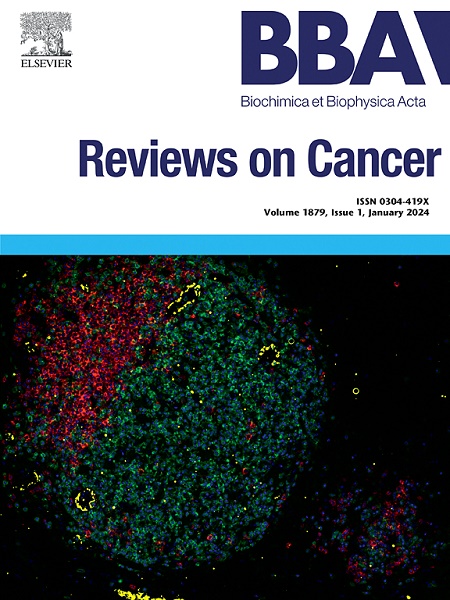从发现到一个有趣的抗癌靶点:人类BCL-2启动子g -四重体和i-基序。
IF 9.7
1区 医学
Q1 BIOCHEMISTRY & MOLECULAR BIOLOGY
Biochimica et biophysica acta. Reviews on cancer
Pub Date : 2025-07-20
DOI:10.1016/j.bbcan.2025.189391
引用次数: 0
摘要
癌症是一个全球性的负担,需要创造性的解决办法。在癌症的几个标志中,BCL-2癌基因的过度表达是癌细胞增殖和进展的一个因素。靶向BCL-2癌基因的转录机制是一种有效的治疗癌症的方法,因为化疗由于其灾难性的毒性和伴随的副作用导致了巨大的问题。BCL-2基因的转录主要由P1启动子及其上游区域控制,该区域富含g,可折叠成g -四联体(G4)和i-motif结构。G4和i-motif是核酸的二级结构,为结合蛋白、小分子、肽核酸等提供了平台。这种二级结构是有针对性的,在过去几年中已经得到了广泛的研究。因此,深入研究BCL-2基因的G4和i基序结构及其作为治疗靶点的潜力是合理的。在这里,我们将概述BCL-2 G4和i-motif结构以及与P1启动子结合的蛋白质的发现和结构。最后,我们将讨论BCL-2 G4和i-motif结合的小分子/配体,以及它们的抗癌活性,并研究它们在创新癌症治疗方面的潜力。本文章由计算机程序翻译,如有差异,请以英文原文为准。

From unearthing to an intriguing cancer-fighting target: the human BCL-2 promoter G-quadruplex and i-motif.
Cancer is a global burden that calls for creative solutions. Among the several hallmarks of cancer, overexpression of the BCL-2 oncogene serves as a factor for cancer cell proliferation and progression. Targeting the transcription machinery of the BCL-2 oncogene is an effective approach against cancer since chemotherapy causes huge problems due to its catastrophic toxicity and accompanying side effects. Transcription of the BCL-2 gene is primarily controlled by the P1 promoter and its upstream region, which is G-rich and can fold into G-quadruplexes (G4 or GQ), and i-motif structures. G4 and i-motif are secondary structures of nucleic acids that provide a platform for binding proteins, small molecules, peptide nucleic acids, etc. Such secondary structures can be targeted and have been extensively studied in the past few years. Therefore, it is reasonable to carry out an in-depth investigation of the G4 and i-motif structures in the BCL-2 gene and its potential as a therapeutic target. Here, we will overview the discovery and structure of BCL-2 G4 and i-motif structure and the proteins that bind to P1 promoter. Lastly, we will discuss BCL-2 G4 and i-motif binding small molecules/ligands, and their anticancer activities and examine their potential for innovative cancer treatments.
求助全文
通过发布文献求助,成功后即可免费获取论文全文。
去求助
来源期刊

Biochimica et biophysica acta. Reviews on cancer
医学-生化与分子生物学
CiteScore
17.20
自引率
0.00%
发文量
138
审稿时长
33 days
期刊介绍:
Biochimica et Biophysica Acta (BBA) - Reviews on Cancer encompasses the entirety of cancer biology and biochemistry, emphasizing oncogenes and tumor suppressor genes, growth-related cell cycle control signaling, carcinogenesis mechanisms, cell transformation, immunologic control mechanisms, genetics of human (mammalian) cancer, control of cell proliferation, genetic and molecular control of organismic development, rational anti-tumor drug design. It publishes mini-reviews and full reviews.
 求助内容:
求助内容: 应助结果提醒方式:
应助结果提醒方式:


